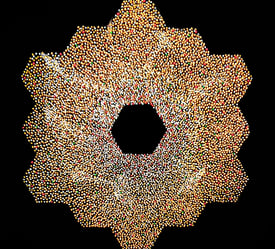Work no. 7, 1080 mm x 1080 mm, 2022
Celestial Collection, Jay Horan
The James Webb Space Telescope is the largest high-resolution telescope in space. Launched in 2021, scientists can now view objects too old, distant, or faint for the Hubble Space Telescope to capture.
As a successor to the Hubble Space Telescope, the Webb Space Telescope will enable further research and investigations into astronomy and cosmology in deep space. Its primary aim is to observe the first stars, birthed more than 13 billion years ago during the formation of the first galaxies, asterisms (also known as constellations), and the characteristics and details of atmospheric exoplanets.
The Webb Space Telescope project was formerly known as the ‘Next Generation Space Telescope’ (NGST). In 2002, it was renamed after NASA’s second administrator, James E. Webb. Webb laid the foundations at NASA during the most successful period of astronomical discoveries in the 1960s. Webb supported the science behind the scenes and made an overwhelming contribution as a manager and a leader, resulting in positive impacts on productivity, effectiveness and efficiency of the performance of NASA’s operations. As a tribute, the space telescope was renamed in his honour.
The Webb Space Telescope’s primary mirror is made of gold-plated beryllium, consisting of 18 hexagonal mirror segments, equal to a 6.5-metre diameter primary mirror (25 sqm when combined), giving its mirror a collecting area six times that of the Hubble Space Telescope. Also, the Webb Space telescope observes the Universe primarily in the infrared spectrum (longer wavelengths) as opposed to the Hubble, which studies the Universe primarily at optical (visible light) and ultraviolet wavelengths, though it has some infrared capability.
On 11 July 2022, NASA released their first full-colour, high-resolution infrared images from the Webb Space Telescope. The new images of intense clusters of stars were extraordinarily detailed and breathtakingly stunning. So far, the Hubble Space Telescope has discovered over 100 billion galaxies; the Webb Space Telescope has a high probability of discovering further billions of galaxies.
Emotions were high for scientists and enthusiasts when the latest images were retrieved from the Webb Space Telescope. These experiences contributed to the inspiration for the artwork.
We experience explicit and implicit emotions, both positive and negative, and we may recall and re-experience those emotions at various levels of intensity. According to scientific findings, more than 34,000 human emotions have been investigated. Furthermore, research into emotions challenges scientists to categorise a research field that invites further inquiry.
Journey
The correspondence I noticed between the scientific findings, the Webb Space Telescope’s design, human emotions, and the images of the stars led me on a quest to plan and craft an abstract art piece inspired by the James Webb Space Telescope. More about my journeys are listed below.
Jay Horan


Read more about my journeys:
The James Webb Space Telescope and the Universe of Emotions
Sources
Gardner, J.P., Mather, J.C., Clampin, M. et al. (2006). The James Webb Space Telescope. Space Science Review, 123, 485–606. https://doi.org/10.1007/s11214-006-8315-7
Institute for Advanced Study (IAS). (2022, August 4). IAS scholars on the James Webb Telescope’s first images. https://www.ias.edu/news/ias-scholars-james-webb-telescopes-first-images
McConnell, A.R. (2022, July 13). Webb Telescope can inspire hope when we need it Mosthttps://www.psychologytoday.com/us/blog/the-social-self/202207/webb-telescope-can-inspire-hope-when-we-need-it-most
NASA. (n.d.). James Webb Resources. https://jwst.nasa.gov/index.htmlhttps://www.nasa.gov/mission_pages/webb/about/index.htmlhttps://jwst.nasa.gov/content/about/faqs/whoIsJamesWebb.html
NASA. (n.d.). Webb vs Hubble Telescope. https://webb.nasa.gov/content/about/comparisonWebbVsHubble.html
University of Canterbury. (2022, July 14). Expert’s reaction to first images of the James Webb telescope. https://www.canterbury.ac.nz/news/2022/james-webb-telescopes-first-pictures-expert-reaction.html
